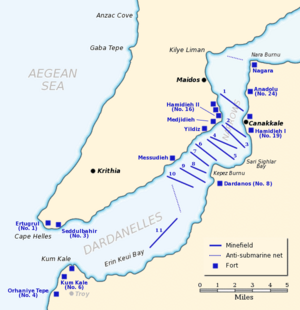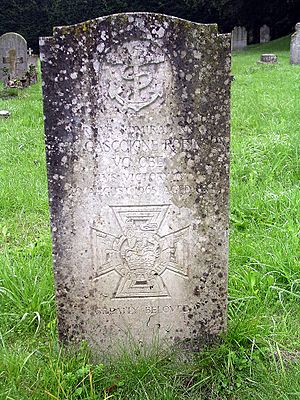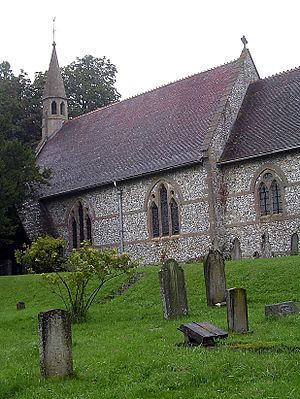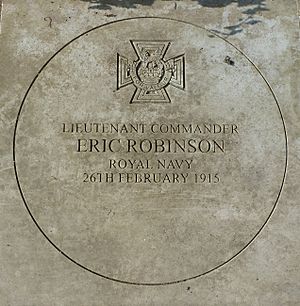Eric Gascoigne Robinson facts for kids
Quick facts for kids
Eric Gascoigne Robinson
|
|
|---|---|
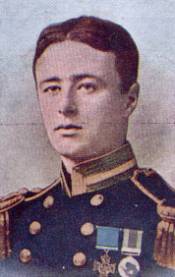
Eric Robinson, VC from Gallaher Cigarette Cards
|
|
| Born | 16 May 1882 Greenwich, Kent |
| Died | 20 August 1965 (aged 83) Gosport, Hampshire |
| Allegiance | United Kingdom |
| Service/ |
Royal Navy |
| Years of service | 1897–1933 1939–1942 |
| Rank | Rear Admiral |
| Commands held | HMS M21 |
| Battles/wars | Boxer Rebellion First World War |
| Awards | Victoria Cross Officer of the Order of the British Empire Mentioned in Despatches (2) Order of the Nile, Fourth Class (Egypt) Knight, Order of St Anna (Russia) Order of the Sacred Treasure (Japan) Knight, Legion of Honour (France) Croix de Guerre (France) King Haakon VII Freedom Cross (Norway) |
Rear Admiral Eric Gascoigne Robinson (born May 16, 1882 – died August 20, 1965) was a brave officer in the Royal Navy. He received the Victoria Cross (VC), which is the highest award for bravery in battle for British and Commonwealth soldiers. He earned this award during the First World War by bravely destroying a Turkish gun battery all by himself. This happened during the Gallipoli campaign while he was a lieutenant commander off the coast of the Dardanelles.
After his amazing acts, he was badly hurt on the front lines in Gallipoli. But he got better and kept serving through the rest of the war and into the Russian Civil War. In 1939, when he was 57, he volunteered for duty again. He spent three more years at sea, guiding groups of ships (called convoys) during the Battle of the Atlantic. Throughout his long career, Robinson was known as a highly respected officer who fought in four wars.
Contents
Eric Gascoigne Robinson was born in 1882 in Greenwich, Kent. His father was a chaplain at the Royal Naval College. This meant Eric grew up preparing for a life at sea. He went to St John's School, Leatherhead before joining the naval training ship HMS Britannia in 1897 at age fifteen.
He quickly moved to larger ships like the battleship HMS Majestic and the cruiser HMS Endymion. On the HMS Endymion, he helped stop the Boxer Rebellion in China. At just 18, he saw his first battle there. He was wounded and praised for his daring and clever actions. He stayed in China for several years before returning to England. In 1907, he became an expert in torpedoes at HMS Vernon in Portsmouth.
In 1910, Robinson became a Lieutenant Commander. He served on various ships and at naval bases. In 1913, he married Edith Gladys Cordeux and they had three children. Soon after his wedding, he was sent to the Mediterranean Sea at the start of the First World War on the battleship HMS Vengeance.
Heroic Actions at Gallipoli
Robinson's brave actions that earned him the Victoria Cross came from his close friendship with another daring officer, Roger Keyes. Keyes asked Robinson to lead an attack on a Turkish gun battery called Orkanieh. This battery was located on the southern shore of the Dardanelles. It had resisted attacks from Allied battleships for weeks. Robinson was chosen to lead a team of sailors and Royal Marines to destroy the battery and then leave safely.
Robinson accepted the mission right away. His team landed without being seen early on February 26. They destroyed two small cannons and quickly moved towards the main battery. However, Turkish snipers soon pinned them down. The sailors' white uniforms made them easy targets, and more Turkish soldiers arrived to try and trap the raiding party.
Instead of retreating, Robinson led his men through hidden paths. They came out near a small hill behind the main battery. This open hill was covered by Turkish snipers. But Robinson knew how important it was to destroy the artillery guns that overlooked the sea. So, he let a junior officer take command of the team. Then, he climbed the hill alone, dodging bullets in his white uniform. He reached the top unharmed and returned a few minutes later, seemingly unfazed by the heavy gunfire. People said he was "strolling around... under heavy rifle fire... like a sparrow enjoying a bath from a garden hose."
The battery was empty, so Robinson was able to set explosives. He destroyed the large 9.4-inch main gun and two anti-aircraft guns. As they retreated, Robinson avoided the Turkish soldiers. He then directed gunfire from the fleet onto the Turkish positions, causing many casualties. Admiral John de Robeck, who watched from his ship HMS Queen Elizabeth, immediately recommended Robinson for the Victoria Cross.
In March, Robinson led four dangerous missions to clear sea mines around the beaches of Gallipoli. On one mission, his minesweeper was hit by small shells 84 times. The other operations were just as risky. But despite the Turkish resistance, Robinson cleared wide paths for the invasion forces.
The E15 Submarine Mission
In April, Robinson volunteered for an even more dangerous mission. A British submarine, HMS E15, had gotten stuck near Turkish guns. All attempts to destroy it had failed, and it was crucial that the enemy did not capture it. Robinson took command of two small boats, called picket boats, from the battleships HMS Triumph and HMS Majestic. Each boat carried two torpedoes.
On April 18, they entered the Dardanelles in the dark. They were caught in searchlights and faced heavy fire from Turkish artillery and machine guns. Amazingly, both boats reached the submarine unharmed. A Turkish searchlight briefly lit up the E15 by accident. The boat from HMS Majestic, led by Lt Goodwin, quickly attacked. The first torpedo missed. Moments later, a shell hit the boat, damaging its back and badly wounding a crew member. But Goodwin didn't give up. He attacked again and hit the submarine with his second torpedo, destroying it.
Seeing his partner's trouble, Robinson immediately went to the damaged boat. He rescued its crew and then escaped back to safety. It's estimated that the Turks fired at least 500 heavy shells at the two boats in just a few minutes. A German officer later said he had never seen such a brave and fearless attack. Many believed this action should have earned Robinson a second Victoria Cross. Instead, he was promoted to Commander.
Later War Service
In August, Robinson went to Anzac Cove as a naval officer. On his second day there, he was badly wounded near the front line. He had to be sent back to the UK to recover. There, King George V presented him with his Victoria Cross medal at Buckingham Palace.
After recovering, he returned to the Mediterranean in December 1915. He took command of the coastal monitor HMS M21. From this ship, he shelled Turkish positions in Egypt and Palestine. He was again praised for his actions and received the Egyptian Order of the Nile.
In 1917, he returned to England. He later commanded a secret section of the Royal Navy's Signals School. This led to a posting in the Caspian Sea during the Russian Civil War. There, he fought against Bolshevik forces along the Russian coastline. Robinson commanded a group of coastal torpedo boats and forced several enemy forts to surrender with his aggressive tactics. For these achievements, he later received the Russian Order of St. Anna. His most notable act was leading a small boat into the harbor of Fort Alexandrovsk. He sank an enemy barge, which led to a mass surrender from the fort's soldiers.
Life After the Wars
After his long service, Robinson returned home. He was made an Officer of the Order of the British Empire by the King for his work in the Caspian Sea. He was promoted to captain and served on HMS Iron Duke (1912) (HMS Iron Duke). Robinson then worked in training centers and naval dockyards. He also had a short time with the Far East Fleet, where he received the Japanese Order of the Sacred Treasure for his service. In 1925, he joined the Freemasons and remained an important member for the rest of his life.
He retired in 1933 at age 51 as a Rear Admiral. But when the Second World War started, Robinson immediately offered to serve again. For three years, he commanded convoys of ships crossing the Atlantic Ocean. For this service, he later received the Norwegian King Haakon VII's Freedom Cross.
In 1942, he retired for a second time. This was due to his age, the stress of long service, and the sad death of his son, Midshipman Edward Cordeaux Robinson. His son died when his ship, the cruiser HMS Neptune, sank in December 1941.
Retirement and Legacy
Robinson settled in the village of Langrish in Hampshire. He passed away peacefully at Haslar Naval Hospital in Gosport on August 20, 1965. He was buried at St John's, the village church where he had served as a warden for 20 years.
For many years, his grave did not have a headstone. However, a large plaque honoring him was placed near the altar by his sister in 1969. In 1998, after investigations by the Naval VC Association, his grave was found. A headstone was then put up by the Commonwealth War Graves Commission. At the dedication ceremony, Admiral Derek Reffell spoke, saying: "The admiral was a hero, but more importantly he was a naval man from the finest mould. Now at last we can accord him the dignity he deserves."
Remembering Eric Robinson
On February 26, 2015, exactly one hundred years after he won his Victoria Cross, a special paving stone was placed outside Robinson's old home at 1 Diamond Terrace, Greenwich. At the event, Rear Admiral Matthew Parr said he was amazed by Lt Cdr Robinson’s "selfless actions." He added: "His courage, determination and fortitude in the face of overwhelming enemy action remain an example to us all; this commemorative stone will serve as a permanent memorial to a remarkable man."



